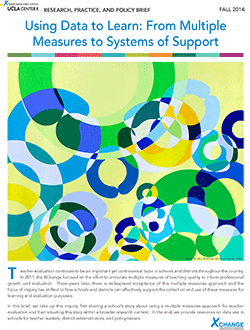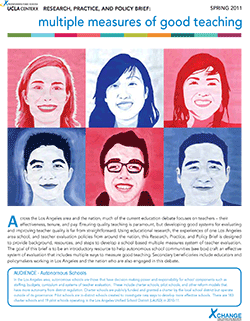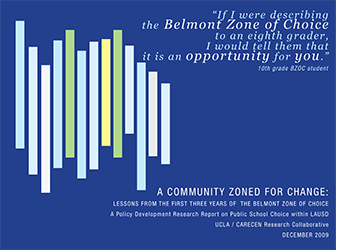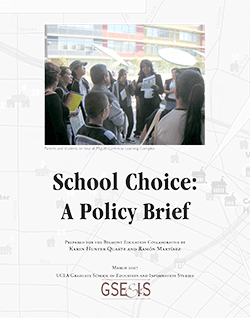 |
Using Data to Learn: From Multiple Measures to Systems of Support
Research, Practice and Policy Brief
Published 2014
Teacher evaluation continues to be an important yet controversial topic in schools and districts throughout the country. In 2011, we focused on the effort to articulate multiple measures of teaching quality to inform professional growth and evaluation (see below). Three years later, there is widespread acceptance of this multiple measures approach and the focus of inquiry has shifted to how schools and districts can effectively support the collection and use of these measures for learning and evaluation purposes.
In this brief, we take up this inquiry, first sharing a school’s story about using a multiple measures approach for teacher evaluation and then situating this story within a broader research context. In the end, we provide resources on data use in schools for teacher leaders, district administrators, and policymakers.
Read the brief…
|
 |
Teacher Collaborative Inquiry
Research, Practice and Policy Brief
Published 2014
When teachers work together using an inquiry process to solve problems of practice, the benefits to students and schools are enormous. In 2009, UCLA Center X launched an ambitious grant program to support collaborative teacher inquiry and has since funded and facilitated 75 Teacher Initiated Inquiry Projects (TIIP) across three cohorts. This brief shares the evaluation research on on the first two cohorts, links to exemplary projects, and situates the work of collaborative teacher inquiry in the larger policy effort to promote teacher professionalism.
Read the brief…
|
 |
Multiple Measures of Good Teaching
Research, Practice and Policy Brief
Published 2011
Across the Los Angeles area and the nation, much of the current education debate focuses on teachers – their effectiveness, tenure, and pay. Ensuring quality teaching is paramount, but developing good systems for evaluating and improving teacher quality is far from straightforward. Using educational research, the experiences of one Los Angeles area school, and teacher evaluation policies from around the nation, this Research, Practice, and Policy Brief is designed to provide background, resources, and steps to develop a school-based multiple measures system of teacher evaluation.
The goal of this brief is to be an introductory resource to help autonomous school communities craft an effective system of evaluation that includes multiple ways to measure good teaching. Secondary beneficiaries include educators and policymakers working in Los Angeles and the nation who are also engaged in this debate.
Read the brief…
|
 |
A Community Zoned for Change: A School Choice Policy Development Research Report
Research Report
Published 2009
In communities with historically limited public education opportunities, how do people come together to improve their schools? In the Pico Union community of central Los Angeles, within Local District 4 of the Los Angeles Unified School District, grassroots groups responded to the challenge by organizing a school choice plan. This reform—the Belmont Zone of Choice (BZOC)—engages teachers, community members, families, and students in a portfolio of neighborhood small schools that share a common set of high expectations for all students—college readiness, career preparation, and civic participation.
This report documents the origins, features, and consequences of the BZOC from a variety of perspectives. Our intent is to provide timely information and insights to help improve the process—from January to April 2010—by which students will choose schools and LAUSD administrators will assign students to schools. We also hope the lessons learned will be helpful to LAUSD as it establishes new zones of choice as part of its historic Public School Choice Resolution.
Read the report…
|
 |
School Choice: A Policy Brief
Policy Brief
Published 2007
This policy brief summarizes the range of school choice policies and research on the link between these policies and two forms of educational outcomes: the academic achievement of individual students and the just distribution of common schooling.
Read the brief…
|